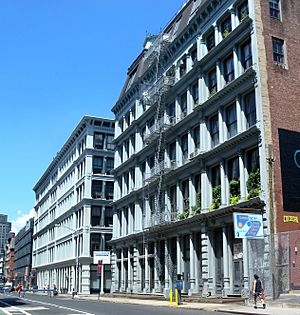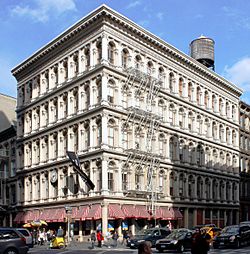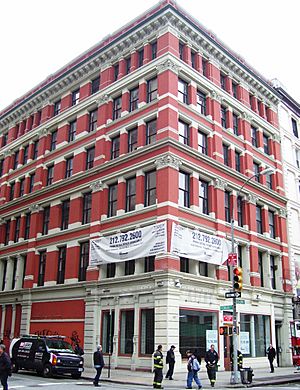SoHo, Manhattan facts for kids
Quick facts for kids
SoHo
|
|
|---|---|

Cast-iron buildings on Grand Street between Lafayette Street and Broadway
|
|
| Country | |
| State | |
| City | New York City |
| Borough | Manhattan |
| Community District | Manhattan 2 |
| Named for | "South of Houston Street" |
| Area | |
| • Total | 0.87 km2 (0.336 sq mi) |
| Population
(2019)
|
|
| • Total | 18,894 |
| • Density | 21,710/km2 (56,230/sq mi) |
| Economics | |
| • Median income | 5,083 |
| Time zone | UTC−5 (Eastern) |
| • Summer (DST) | UTC−4 (EDT) |
| ZIP codes |
10012, 10013
|
| Area code | 212, 332, 646, and 917 |
|
SoHo–Cast Iron Historic District
|
|
| Location | Roughly north to south: Houston to Canal Streets; and west to east: West Broadway or Sixth Avenue to Crosby Street or Lafayette Street Manhattan, New York City |
| Area | 73 acres (30 ha) |
| Architectural style | Renaissance Italianate some Federal |
| NRHP reference No. | 78001883 |
| Significant dates | |
| Added to NRHP | June 29, 1978 |
SoHo is a cool neighborhood in Lower Manhattan, New York City. Its name is short for "South of Houston Street". Since the 1970s, SoHo has been famous for its many artist studios, called lofts, and art galleries. It's also known for its wide variety of shops, from fancy boutiques to big chain stores.
The name "SoHo" was created in 1962 by Chester Rapkin, an urban planner. He wrote a study about the area. The name also reminds people of the Soho area in London, England.
Most of SoHo is part of the SoHo–Cast Iron Historic District. This special area was recognized in 1973 because of its unique buildings. It was later added to the National Register of Historic Places in 1978. The district covers 26 blocks and has about 500 buildings. Many of these buildings feature amazing cast-iron designs. Some of the side streets are even paved with old-fashioned Belgian blocks.
SoHo is part of Manhattan Community District 2. Its main ZIP Codes are 10012 and 10013.
Contents
SoHo: A Cool New York City Neighborhood
Where is SoHo?
SoHo is located in Manhattan. It is bordered by Houston Street to the north and Canal Street to the south. To the east, it reaches Crosby Street, and to the west, it goes up to Sixth Avenue. Some maps show the western boundary north of Broome Street as West Broadway.
The Special Historic District
The SoHo-Cast Iron Historic District is a protected area within SoHo. It was made bigger in 2010 to include more of West Broadway and extend east to Lafayette and Centre Streets. This means many of the beautiful old buildings are kept safe.
SoHo's Interesting History
Early Days
Long ago, during the colonial period, the land that is now SoHo was farmland. It was given to freed slaves by the Dutch West Indies Company. This was the first free Black settlement on Manhattan island. Later, the land changed hands several times.
In the 1700s, natural features like streams and hills stopped the city from growing north into this area. So, it stayed mostly rural. During the American Revolution, there were many forts and defenses here. After the war, the land was divided into smaller pieces. But still, not much was built, except for some factories near Broadway and Canal Street.
Real development started when the city drained the Collect Pond. This pond used to be a fresh water source, but it became dirty. After the pond was filled in, and Broadway and Canal Street were paved, more people started to live there.
From Shops to Factories
By the mid-1800s, the old homes were replaced by stronger buildings made of stone and cast iron. Big stores like Lord & Taylor and Tiffany & Company opened along Broadway. Grand hotels and theaters also appeared. Broadway, between Canal and Houston Streets, became a busy shopping and entertainment area. Many small businesses, like cabinet makers and brass firms, also set up shop.
However, this change caused many residents to move away. After the Civil War, large manufacturers, especially textile companies, moved into the area. SoHo became a center for wholesale goods. But by the end of the 1800s, as the city's main center moved uptown, the quality of the area went down.
After World War II, the textile industry moved away. Many large buildings in SoHo became empty. Some were used as warehouses or printing plants. Others were torn down for gas stations and parking lots. By the 1950s, the area was known as Hell's Hundred Acres. It was an industrial area, busy during the day but empty at night.
The Amazing Cast-Iron Buildings
SoHo has the largest collection of cast-iron architecture in the world! About 250 cast-iron buildings are in New York City, and most of them are in SoHo. Cast iron was first used to make old buildings look new and fancy. This helped them attract new businesses. Most of these beautiful fronts were built between 1840 and 1880. Later, new buildings were designed to use cast iron from the start.

Cast iron was cheaper than stone or brick for building fronts. Molds were used to create detailed decorations, and broken pieces could be easily replaced. Buildings could be built very quickly, sometimes in just four months! Even though they were fast to build, the designs were still very detailed. Architects often copied designs from classic French and Italian buildings. Cast iron was painted to look like stone, which was a popular building material.
There were many cast iron factories in New York, like Badger's Architectural Iron Works.
Because iron is flexible, beautiful curved window frames could be made. The strength of the metal allowed for very tall windows, letting lots of sunlight into the buildings. Cast iron also allowed for high ceilings and thin support columns, making the insides of buildings feel open and useful.
At first, people thought cast iron was stronger than steel and would resist fire. But when cast iron gets hot, it bends, and then cracks when hit with cold water. So, in 1899, a rule was made that cast-iron fronts had to be backed with brick or stone. Most of the buildings you see today are built this way. The invention of steel eventually ended the cast-iron building era.
Saving SoHo from a Highway
In the 1960s, there were plans to build two huge elevated highways right through SoHo. This project, led by Robert Moses, aimed to connect bridges on the east side with the Holland Tunnel on the west.
However, people who cared about historic preservation and buildings fought against these plans. They were worried about losing many valuable 19th-century cast-iron buildings. These buildings were not seen as important by everyone at the time.
When John V. Lindsay became mayor in 1966, he tried to push the highway project forward. But thanks to the efforts of Jane Jacobs, Tony D'Apolito, and local artists and leaders, the project was stopped.
Artists Discover SoHo
After the highway plans were dropped, the city had many historic buildings that were empty. The upper floors of these buildings were originally designed as commercial Manhattan lofts. They had large, open spaces with big windows, perfect for factories. Artists loved these spaces because they were big, had lots of natural light, and were cheap to rent.
Many artists started living in these spaces, even though it was technically against the rules. The city didn't mind much at first because the economy was bad, and no one else wanted the spaces. The artists were using buildings that would have been empty otherwise.
As more artists moved in, the city tried to control it. They were worried about safety because the buildings weren't set up for living. But eventually, the city changed its rules in 1971. This allowed visual artists, certified by the Department of Cultural Affairs, to live and work in the same space. This was called "Joint Live-Work Quarters for artists."
The area was officially named the SoHo-Cast Iron Historic District in 1973.
SoHo Becomes a Shopping Hotspot
In 2005, new residential buildings were allowed on empty lots in the historic district. Even though the area changed, many of the original artists stayed because of rent protection laws. In the mid-1990s, most art galleries moved to another neighborhood called Chelsea. However, some galleries still remain in SoHo today.
SoHo's great location, its cool loft apartments, its unique architecture, and its reputation for artists all helped it become popular. This kind of change, where an area becomes more expensive and popular, is sometimes called the "SoHo Effect." SoHo went from being an area with struggling artists and small factories in the 1970s to a famous tourist spot. People now visit for fashionable clothes and beautiful buildings. It's also home to some of the most expensive real estate in the country.
Today, many chain stores are found in the northern part of SoHo, especially along Broadway and Prince and Spring Streets. The sidewalks here are often full of tourists and vendors selling jewelry and T-shirts. SoHo is known for its mix of big stores and unique boutiques.
SoHo's Population and Community
SoHo is part of a larger area that includes TriBeCa and Little Italy. In 2010, the population of this larger area was about 42,742 people. Most residents are adults, with many between 25 and 64 years old.
SoHo and Greenwich Village residents tend to have more college education than other parts of New York City. About 84% of adults aged 25 and older have a college degree or higher. Students in SoHo and Greenwich Village also do very well in school. For example, the number of elementary school students doing well in math increased from 61% in 2000 to 80% in 2011.
Getting Around SoHo
By Car
SoHo is close to the Holland Tunnel. This tunnel goes under the Hudson River and connects SoHo to Jersey City and New Jersey.
By Subway and Bus
You can easily reach SoHo using the New York City Subway. Here are some lines that stop nearby:
- The A, C, and E train train stops at Spring Street.
- The 1 and 2 train train stops at Houston Street.
- The N, Q, R, and W train train stops at Prince Street.
- The 4, 6 <6> trains train stops at Spring Street.
Buses also serve the neighborhood, including the crosstown M21 on Houston Street and the north–south M1, M55 routes.
Education in SoHo
Schools Near SoHo
There are no public schools directly in SoHo. However, several schools are located just outside its borders:
- Broome Street Academy Charter School (121 Avenue of the Americas)
- Chelsea Career & Technical Education High School (131 Avenue of the Americas)
- NYC Ischool (131 Avenue of the Americas)
- P.S. 130 Hernando de Soto School (143 Baxter Street)
- Unity Center for Urban Technologies (121 Avenue of the Americas)
The Montessori School in SoHo is a private school located at 75 Sullivan Street.
SoHo's Library
The New York Public Library has a branch called Mulberry Street. It's located at 10 Jersey Street. This library is special because it's inside a former chocolate factory!
Images for kids
See also
 In Spanish: SoHo (Nueva York) para niños
In Spanish: SoHo (Nueva York) para niños









